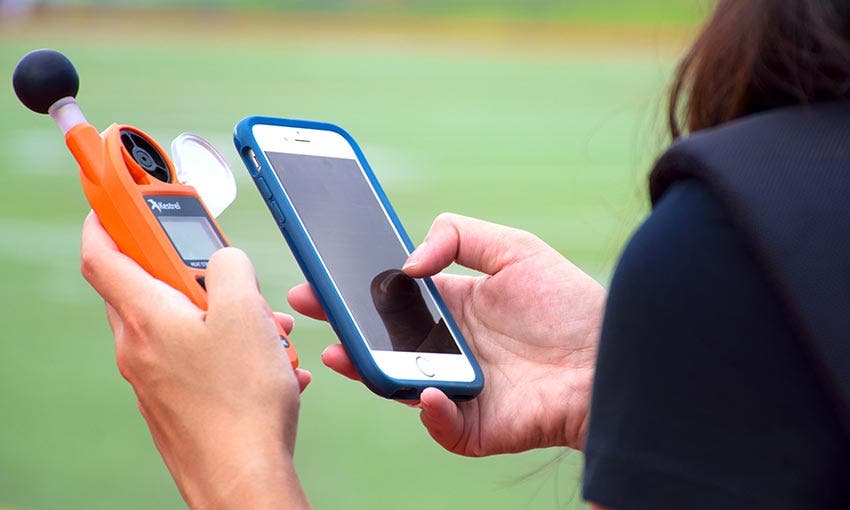Heat Stress Safety as Team Sports Resume

WBGT Monitoring for Accurate Heat Risk Assessment
The lack of organized sports and activities due to widespread closures during the pandemic has undoubtedly impacted the spring and summer training seasons. Concerns arise about athletic conditioning and acclimatization with condensed schedules resulting in less time for hot weather practices before school sports resume in the fall. Ensuring athletes acclimatize to the heat and allowing them to build the necessary fitness level to perform in hot and humid environments will be critical to safety once practice reconvenes.
"Once exercise adaptations have been achieved, it is important to ensure heat acclimatization is also achieved, though these may occur simultaneously."
- Korey Stringer Institute (June 2020). Return to Sports and Exercise During the COVID-19 Pandemic: Guidance for High School and Collegiate Athletic Programs. ( link )
Athletic trainers remain committed to safety by staying up-to-date on the latest recommendations and guidelines with a focus on the prevention of injury. As we enter the practice season and return to athletics, there are new guidelines being released and taken into consideration on how they may affect heat stress safety, especially when it comes to wearing PPE such as face masks during training or rigorous physical activities. The National Federation of State High School Associations (NFHS) recently released its guidelines for returning to high school sports, revealing "one of the primary recommendations involved athletes wearing masks for practice and competition."
Administrators, athletic trainers, directors and coaches are working together to the determine the best ways to implement and adapt precautionary measures into existing plans and protocols. When it comes to heat safety, the circumstances existing for the new normal make monitoring the environment more important than ever in order to properly assess heat stress risk. Accurate onsite data is crucial for identifying conditions that could be dangerous for heat illness, especially with the potential variables of added face coverings and reduced periods of acclimatization resulting from a shorter training season.
Environmental Monitoring with Wet Bulb Globe Temperature
By proactively monitoring the environment, athletic trainers can better assess risk level and take action to prevent or reduce heat-related illness. The recommended measurement used to determine actual environmental heat stress and assessment for heat stress risk is Wet Bulb Globe Temperature or WBGT. The severity of exertional heat stress symptoms depends upon the level of athlete acclimatization and onsite microclimate conditions. These conditions are more likely to occur during hot weather and the severity of symptoms depends upon the level of athlete acclimatization and onsite microclimate conditions.
"As the word heat implies, these conditions most commonly occur during the hot summer months; however, EHS can happen at any time and in the absence of high environmental temperatures."
- Korey Stringer Institute
Athletic Surfaces & Heat Stress Risk
Weather apps miss the mark when it comes to providing microclimate data. Onsite WBGT monitoring will measure actual conditions on each athletic surface. There can be multiple microclimates on a school campus based on the athletic surfaces and variations in temperature, humidity, pressure, wind, sun, shade and reflected/radiant heat. Different types of athletic surfaces result in varying risk levels of heat stress due to the surface itself and the impact of external environmental factors. A 2017 study published in the Journal of Athletic Training shared research findings detailing the disparity between National Weather Service predictive measurements vs the actual, observed onsite WBGT measurements of athletic surfaces.
"WBGT measurements should be taken at regular intervals on each outdoor athletic playing surface to adequately capture the environmental conditions affecting physical performance and the risk of exertional heat illness."
Key Study Findings:
- Using National Weather Service wet-bulb globe temperature (WBGT) resulted in heat-safety category misclassification across all athletic surfaces.
- The National Weather Service WBGT underestimated the local athletic-surface heat stress, especially when the surface was black or red or made of synthetic material.
- Onsite WBGT measurement remains a prudent choice for determining environmental conditions and the need for heat-safety physical-activity modifications or cancellations.
Source:
"The Heat Strain of Various Athletic Surfaces: A Comparison Between Observed and Modeled Wet-Bulb Globe Temperatures"
J. Luke Pryor, PhD, ATC, CSCS*†‡; Riana R. Pryor, PhD, ATC*†‡;
Andrew Grundstein, PhD; Douglas J. Casa, PhD, ATC, FNATA, FACSM‡
Journal of Athletic Training; Volume 52, Number 11, November 2017
About Kestrel Instruments
Kestrel Meters are used by athletic trainers and professionals nationwide to monitor the health and safety of the athletes under their direction. Further, athletic trainers can set the device to store data at specific time intervals and then send the information to their smartphones—making it easier to document, store, and share readings. Trainers are able to conveniently access pre-programmed zones for NATA, ASCM and several state athletics guidelines in the Kestrel 5400 Heat Stress Tracker unit. All of Kestrel’s products are designed and built in the U.S.A and come with a five-year warranty.
www.heatstress.com






